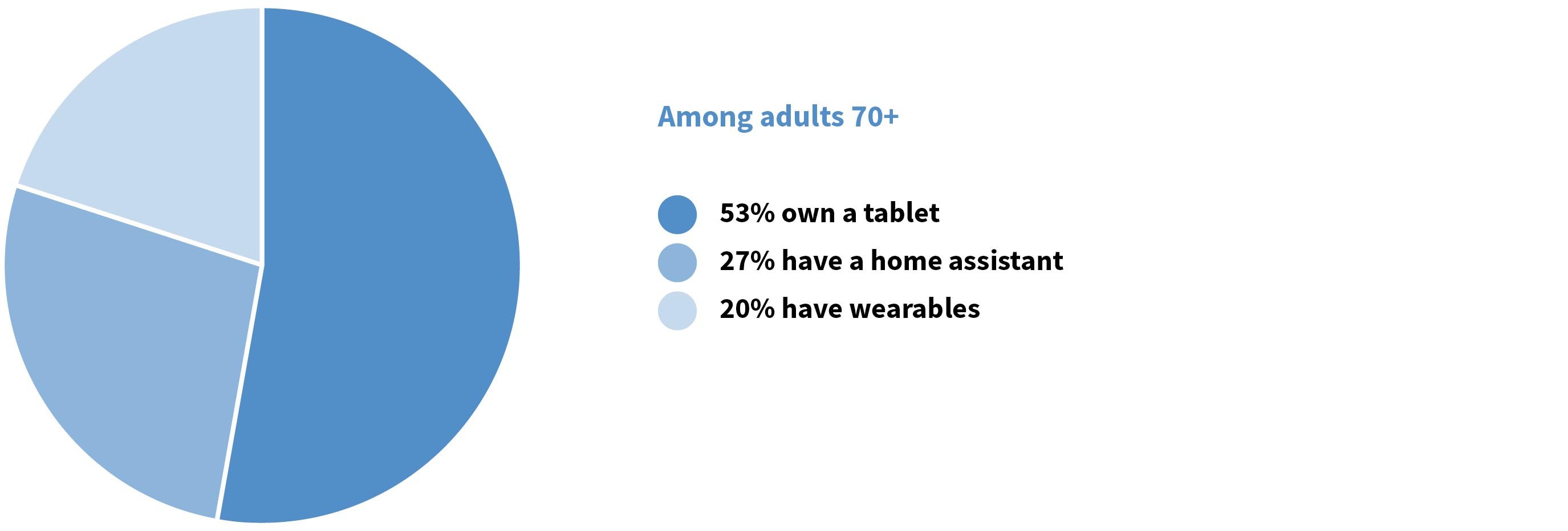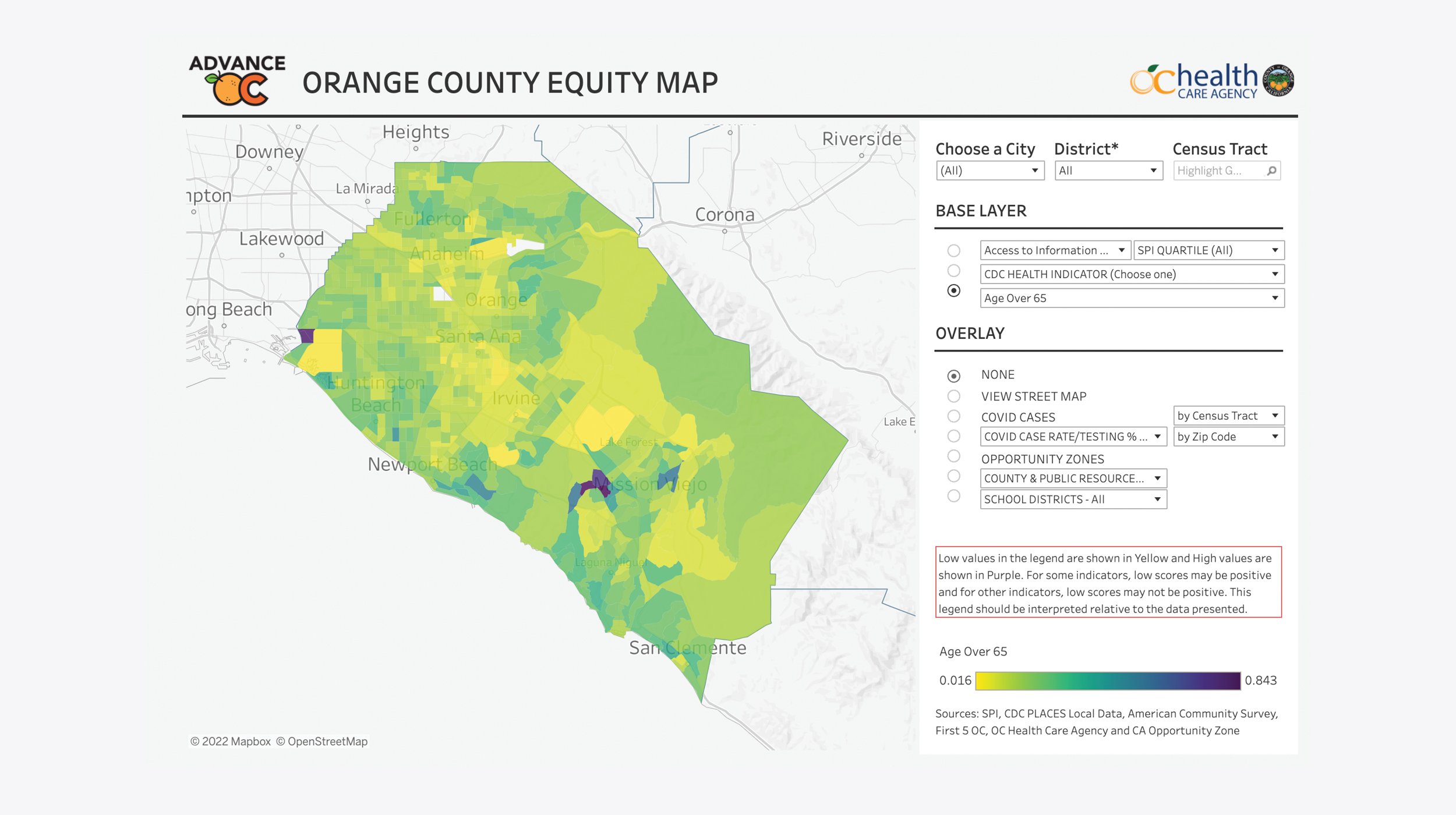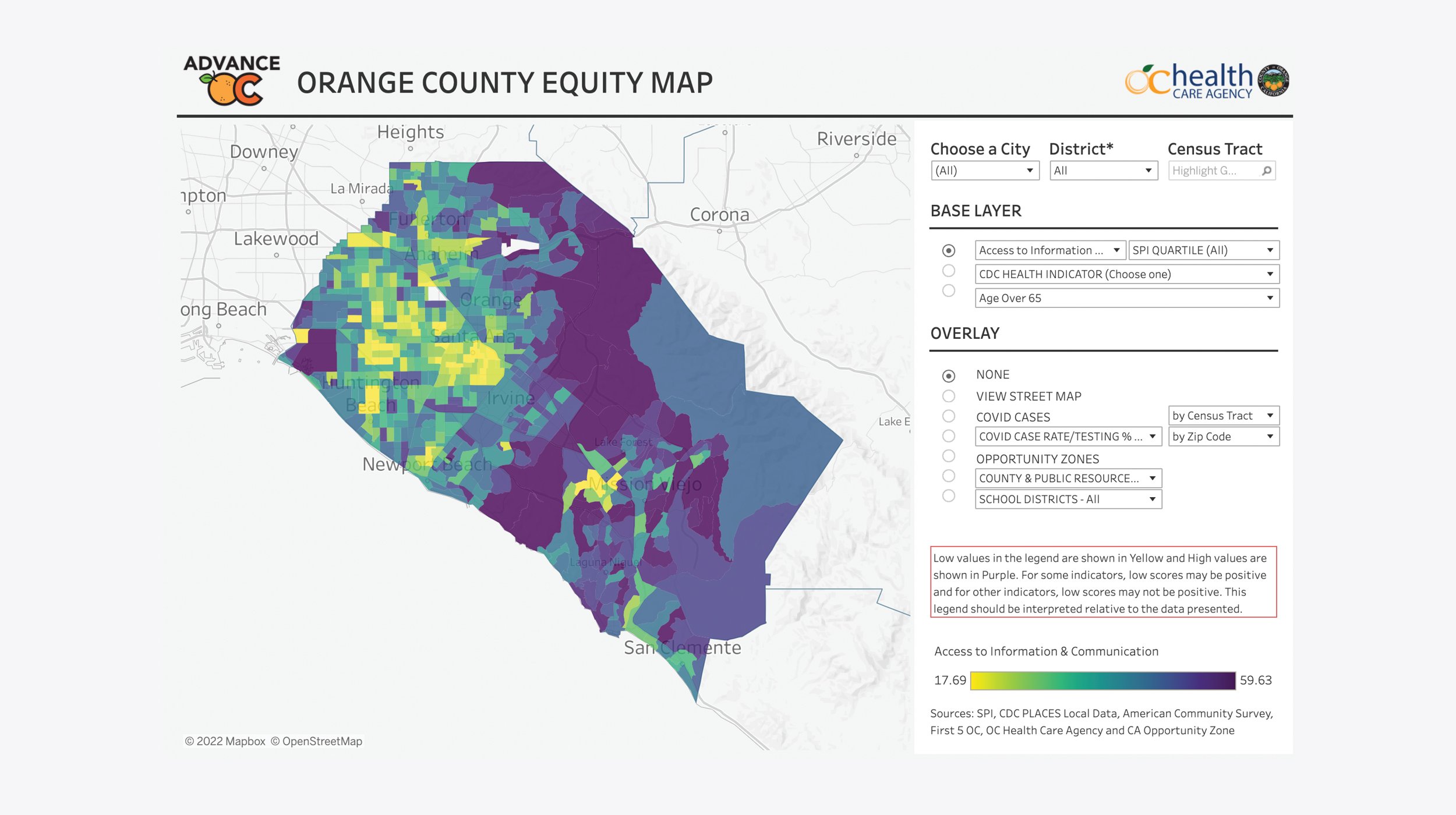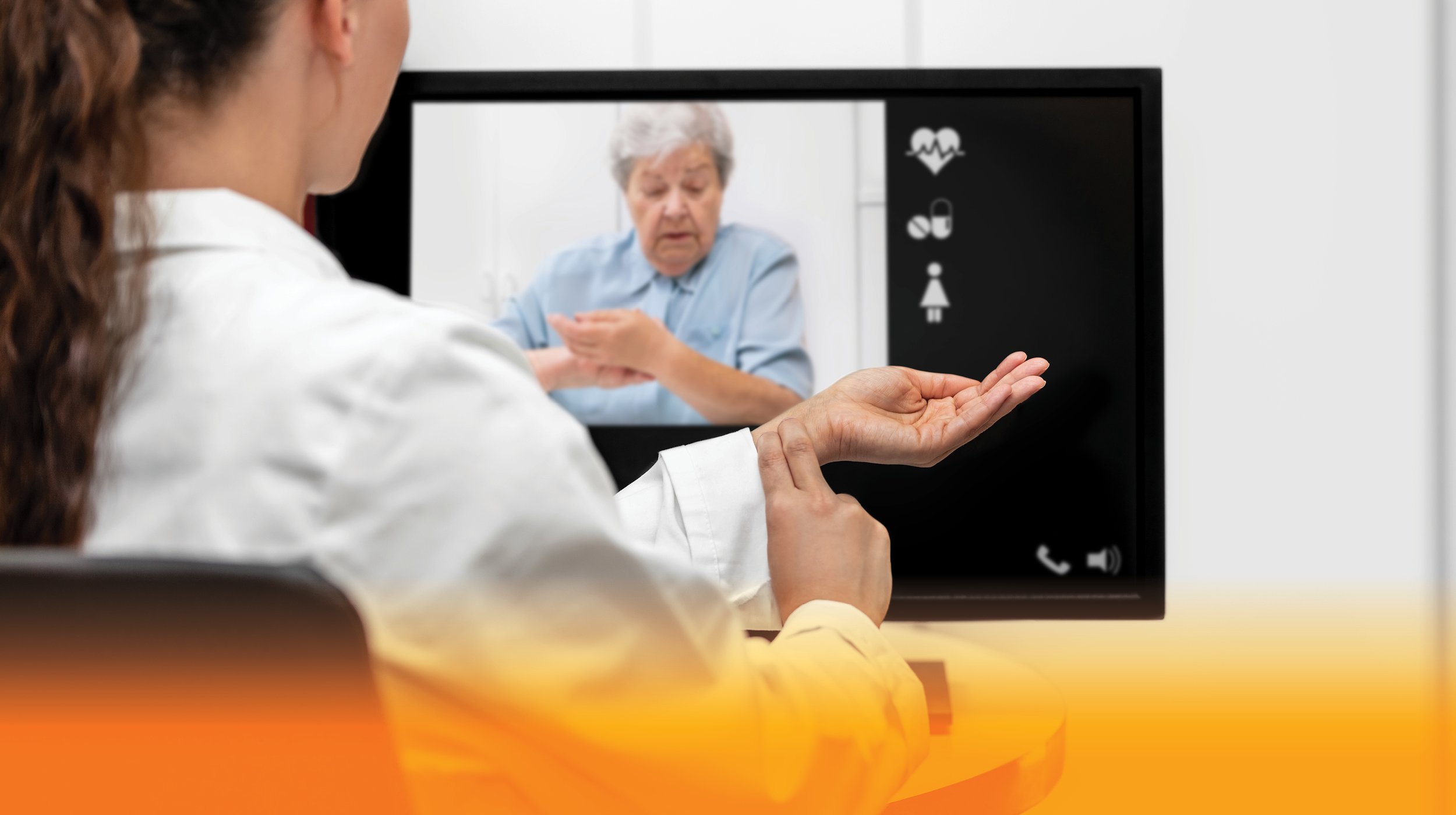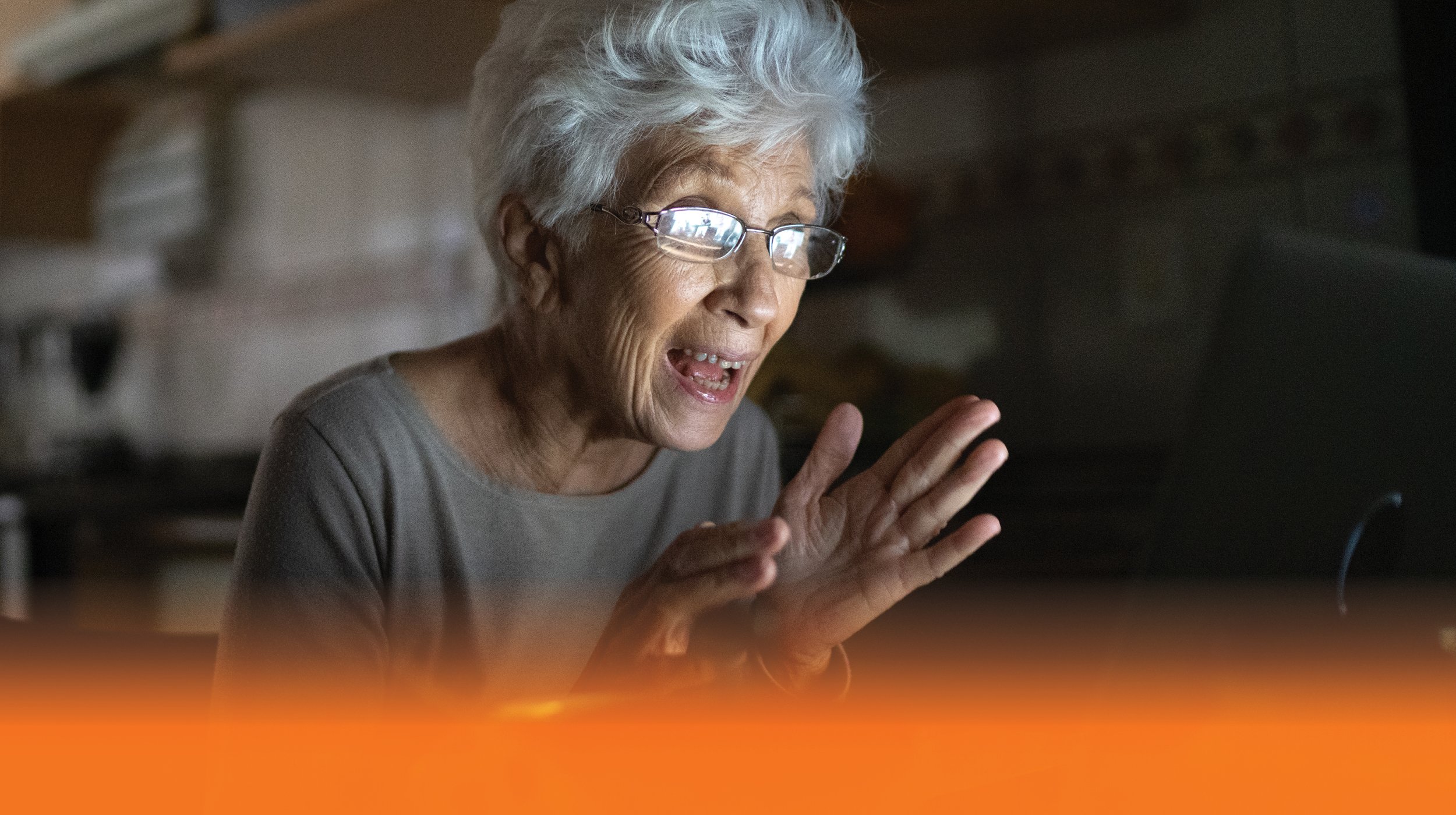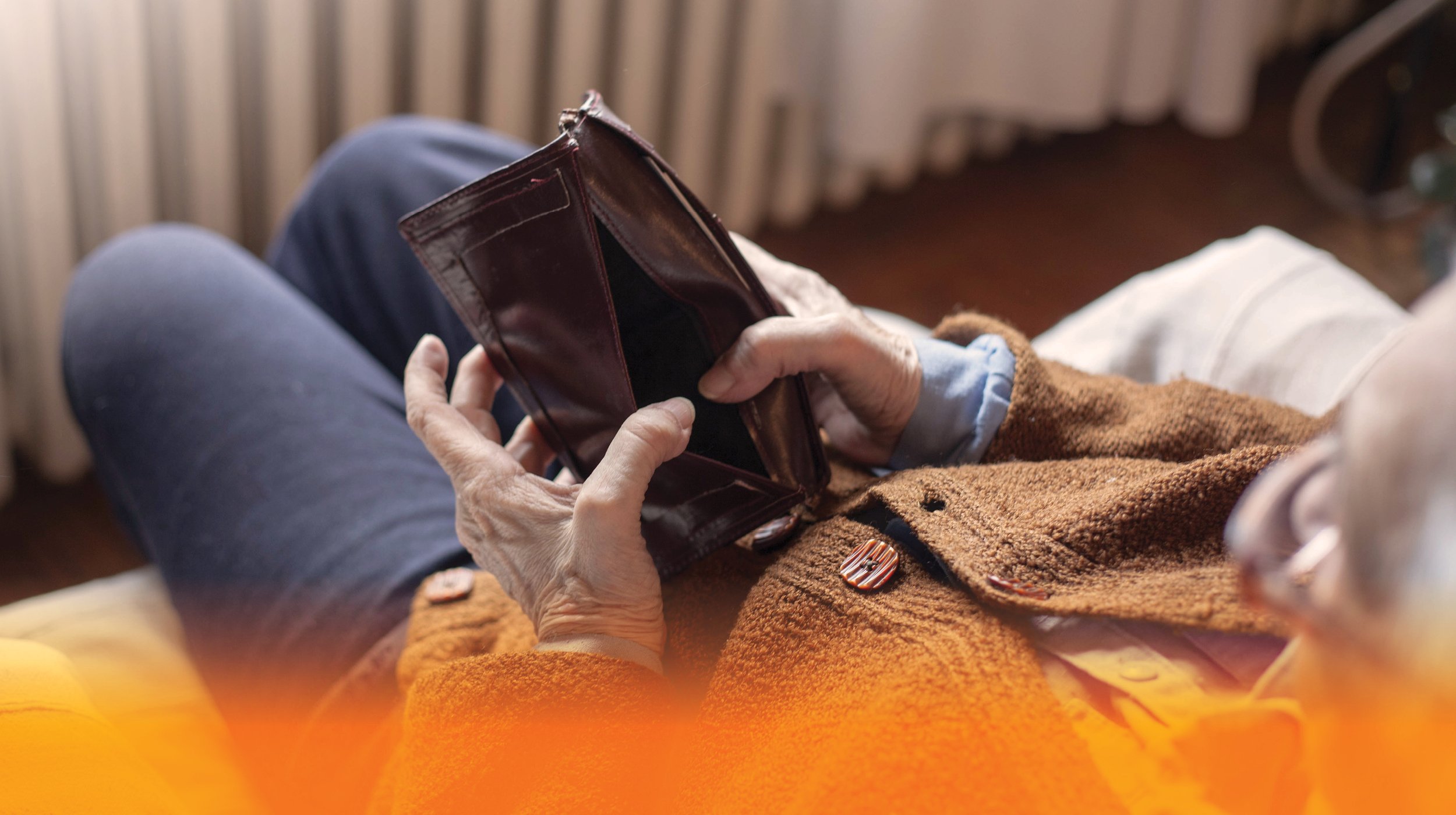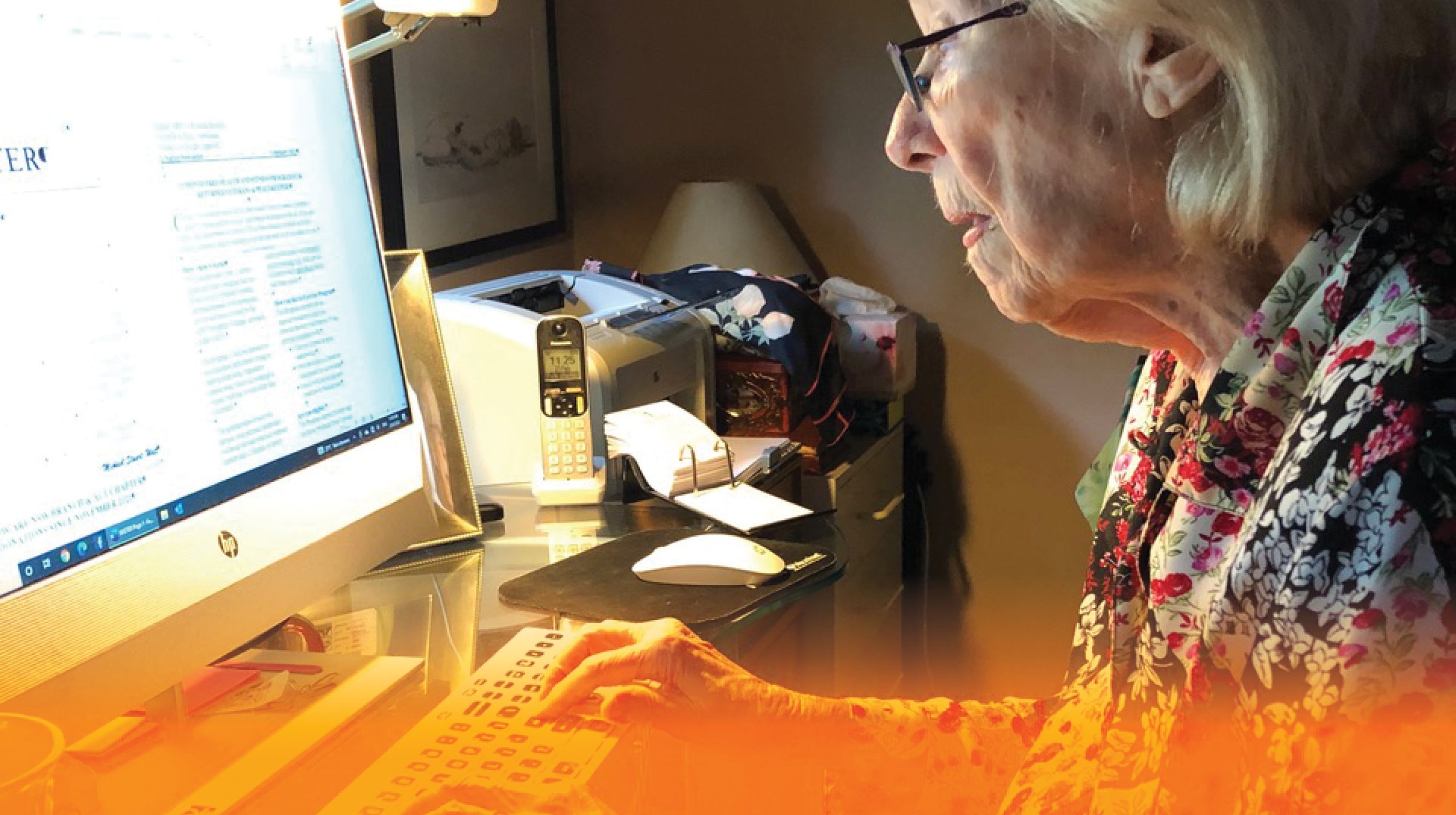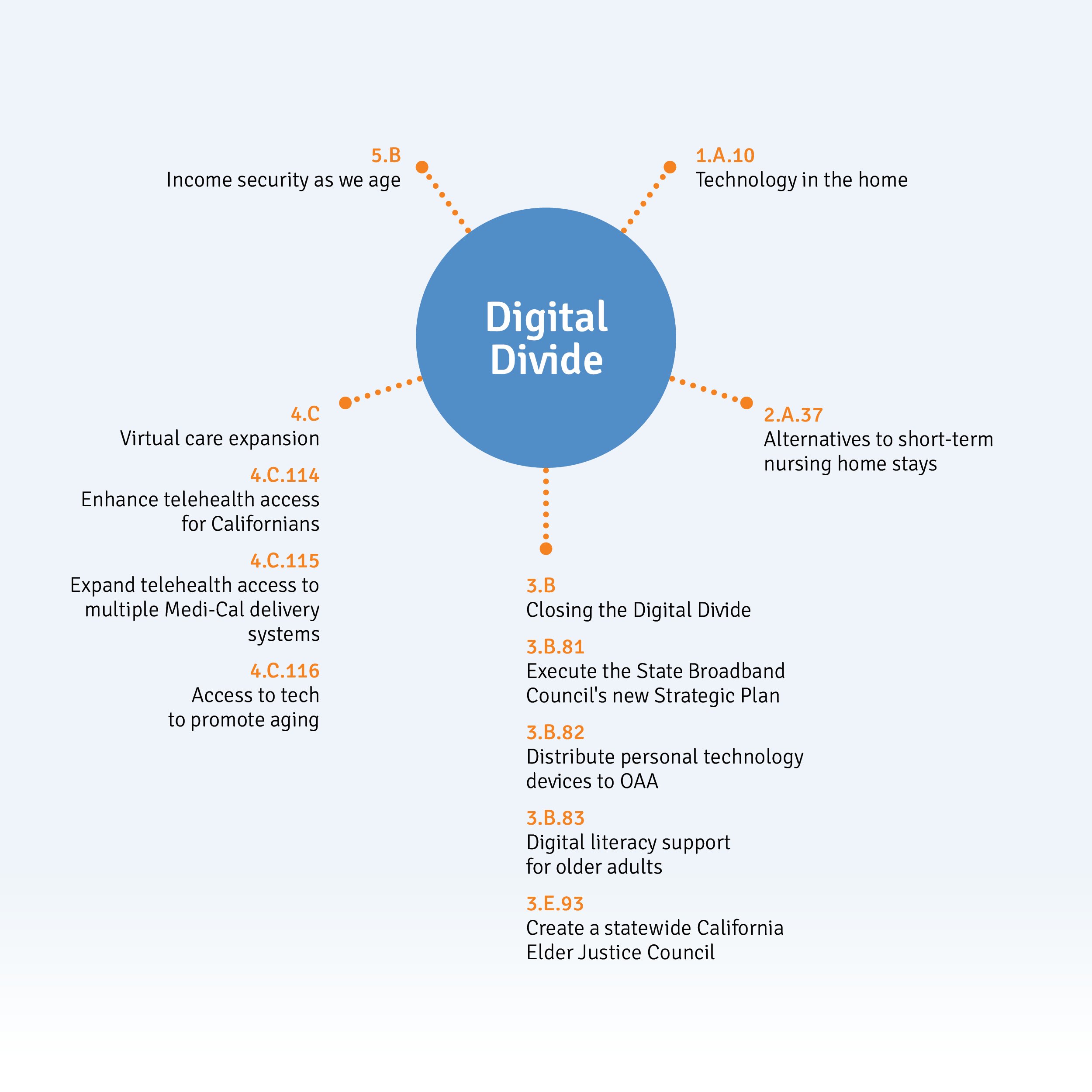Data Overview
Uptake in the USA
In April 2021, AARP released a survey of older users in the first year of the pandemic. The results from 2,250 respondents aged 50+ across America were impressive: Spending on technology by older adults increased 194% - from $394M (in 2019) to $1,144M (in 2020) - buying smartphones, tablets, home assistants, wearables, and smart home technology.
Connection in Orange County
The Digital Divide is a problem of access, adoption, and usage. Measuring how many households have a computer (95.3% in Orange County in 2019) and accessibility to broadband (90.7% broadband subscription in OC in 2019) gives us the first indication that there is a relatively high uptake in Orange County.
According to AARP, Orange County has a lower percentage of older adults without internet (6.0%) compared to both California and the United States. Eighty-percent of older adults have a broadband connection, which is significantly more than both the California and US estimates. Similarly, while 13.1% of older adults do not have a computer, that is lower than the average for both California and the US. And finally, only a very few older adults, 0.8%, have a dial up connection, a lower rate than California and the US.
Overall, computer access in OC is very high, both in terms of hardware and software. 96.9% of the population has at least one computing device. Internet access is also prevalent in the county either via broadband (92.9%) or cellular (84.5%). This leaves approximately 72,532 or 6.9% of County residents without an internet subscription.
Finding at least some of the older adults in the digital divide is possible using Advance OC’s Social Progress Index.
To see the Digital Divide by age: Select “Access to information and communication” in the first pulldown menu; and “Age over 65” in the third pulldown menu.
Source: Orange County Equity Map - Access to information and communication aged 65+
Source: Orange County Equity Map - Access to information and communication all ages
By overlaying these two images and comparing the areas of age and uptake clearly show the areas with highest concentration of older adults (being Laguna Woods, Laguna Hills, Lake Forest, Seal Beach, and La Habra). ALL have the lowest access to information and communication.
Interconnected Issues for Digital Divide
Age and location play a key role in deciding which side of the information divide anyone stands on, with older individuals who live in rural areas being the most disadvantaged technologically. There are, however, many other interrelated factors which grouped into several subcategories:
- Attitudes to Technology
- Capacity
- Affordability
- Support
Attitudes to Technology
Adults aged 60+ are considered “digital immigrants.” Without lifelong exposure to digital media, they’ve had to adapt and incorporate information technology into their lives. This means they risk being cut off from digital solutions such as telehealth, online shopping, banking and digital communication.
And with good reason, fraud and romance scams aimed at older adults resulted in losses of more than $184 million in 2018 much of it online. Many crimes go unreported because victims are scared, embarrassed, or don’t know whom to call. The reality is so endemic, the Dept of Justice has established a national elder fraud hotline which is open from 10am to 6pm Monday to Friday.
“We are deathly afraid of scams. Bring a flier in a printed envelope so that it looks professional or legitimate.”
Adults aged over 65 are 34% more likely to lose money on a financial scam than people in their 40s, according to research by the Stanford Center on Longevity and the Financial Industry Regulatory Authority’s Investor Education Foundation. And almost 1 in 20 elderly respondents in a large 2014 study of New York residents reported being financially exploited at some point in their later lifetime.
“This is such an underreported crime,” said Amy Nofziger of the AARP Fraud Watch Network. In addition, one estimate says only 1 in 44 financial fraud victims report what has happened, often out of embarrassment or fear that their children will want to take control of their finances.
“I’d like to learn more, I’m confident I can learn, but I lack that particular skill.”
The 2021 AARP survey reported an increase in the use of technology across the board from the start of the global pandemic in 2020:
- 82% relied on technology for video chats, texting, email and cell phones
- Video chat rose from 20% to 70%
- 32% of older adults attended their first live, virtual event (e.g. exercise class, birthday party)
- Ordering groceries increased from 6% (2019) to 24% (2020)
- Telehealth consultations increased from 28% in 2019 to 40% in 2020.
As a result, there was also increased interest in learning how to get the most out of their new technology:
54% want to learn more about using tech
39% would use technology more often if they knew how.
“My eyes, ears, and thinking as an older adult make technology much harder. This is something that I didn’t really consider about growing older – that my eyesight and hearing would make other things more difficult.”
In a systematic review of the technology adoption literature, Kavandi and Jaana (2020) found that older adults adopt technology that they perceive as useful and low effort. Self-efficacy, experience, and product design also appear to benefit adoption.
There is some evidence for technology anxiety, health, and privacy or security concerns hindering adoption. The relationship between age and adoption of technology appears to be mediated by cognitive abilities, computer self-efficacy, and computer anxiety, but that research is relatively old.
Pre-Covid, those without regular internet technology, including older adults, could access on-line advice, classes, and computers using public wifi in libraries and at local nonprofits, including senior centers, which would often host technology classes.
While this civic service was suspended due to the pandemic, applying for government programs, finding advice, getting medical attention, using banking services, shopping, and getting help using technology, the need to access them online, rather ironically, increased substantially.
This meant that 6% of older adults in Orange County - or about 29,000 individuals - were excluded from these online options.
To help provide access, the federal government enacted the Emergency Broadband Benefit, a program from the FCC that provides $50 per month towards broadband service and up to $100 towards the purchase of a laptop, desktop, or table computer. (More about solutions to this in the section titled ‘Affordability’)
Capacity
While there is a general perception that older adults are resistant to learning to use technology, a study undertaken in 2017 revealed that most older adults were ‘eager to adopt new technology and willing to learn using a tablet.’ However, they voiced apprehension about the lack of clarity in instructions and support.
“I tried to learn tech but my son wasn't patient and we were both frustrated. I tried doing it by myself, but I don’t know what to Google.”
Being older, users may also have additional physical or mental disabilities that render them homebound and financially insecure. Sight impairment, arthritis, dry skin all affect how users interact with touch screens on smartphones.
“…and I just don’t know a 3 year old to set up my Alexa.”
Although not specific to Orange County, a technology survey in the Philadelphia Inquirer in 2020 found that older adults with dementia (14% of those 71+), hearing loss (nearly two-thirds of those 70+), and vision impairment (13.5% of those 65+) have a hard time using digital devices and programs designed without their needs in mind. They also had problems of design for older adults which include: small icons, difficult-to-read typefaces, inadequate captioning etc.
Within Orange County, there are numerous services aimed at helping older adults with disabilities get online, but accessing these services during the pandemic has been difficult.
“They have classes at the senior center. That’s how I learned to use my device. We had 6 – week classes. There were like 15 of us and one instructor. Everyone had something a little different, but they taught us. We had a group going well until COVID.”
Affordability
Measuring how many people are affected by an inability to connect to the internet or use technology is understandably complex. Nationwide, 15% of older adults (65+) don’t have any type of internet. Two-thirds (66%) say cost is the problem, with average spending being $269 a month (16% of their budget) being beyond their fixed incomes.
The AARP has broken down the tech budget for older Americans. On average, $68 is spent each month on internet connection, $103 for cellphone usage, $78 for cable connection, $20 for streaming services.
Just over a quarter (26%) of rural customers say high-speed connectivity is a problem in Southern California.
These figures are borne out by broadband adoption by household income in 2021:
- <$20k = 70%
- $20k<$39,999 = 92%
- $40,000<$59,999 = 97%
- $60K+ = 99%
Expanding access to high-speed, affordable broadband is an urgent national priority and billions of dollars are in the pipeline for deployment and adoption, including the Biden Administration’s proposed multi-billion dollar infrastructure bill.
The Federal Communications Commission (FCC) launched an Emergency Broadband Benefit Provider (EBB). On Dec. 31, 2021, the EBB became the Affordable Connectivity Program, and assistance of up to $30 per month can be claimed directly through individual providers.
In the already rapidly changing market of technology, the global pandemic has had a massive impact on the way in which older adults use the internet: the first has been a surge in purchase of technology, the second has been a desire to learn how to use it.
Support
The uptake of technology for older users across America in the first year of the pandemic was impressive. Among adults 70+:
- 53% own a tablet
- 27% have a home assistant
- 20% have wearables.
Now, 54% want to learn more about using tech and 39% would use technology more often if they knew how.
In response to a need to bridge the digital divide as outlined in California’s Master Plan for Aging, as well as to assist with combating the mental and physical health implications of social isolation among older adults brought on by the COVID-19 pandemic, the Orange County Board of Supervisors authorized $2.4 million from the County’s allocation of American Rescue Plan Act dollars to fund a Senior Technology Program. The program provided iPads with data plans, individualized training, and access to an online platform of virtual classes that any Orange County resident age 60+ could participate in free of charge. The goal of the program was not only to increase access, but to facilitate participation in various virtual and hybrid activities offered to seniors throughout the County, staying connected with family and friends, as well as support for telehealth appointments that seniors have with doctors and mental health clinicians.
While the need for the Senior Technology Program in Orange County was difficult to measure, one of the indicators used to justify an initial allotment of iPads was the number of older adults who contacted the County’s COVID-19 hotline requesting assistance with vaccine appointment registration which was completely dependent on technology. In their letter to the Board of Supervisors advocating for the Senior Technology Program, the Senior Citizens Advisory Council cited this metric as one important indicator of need among Orange County older adults requiring assistance with technology.
The classes offered by GetSetUp are customized specifically for older adults and are taught by their peers. There are over 2,000 classes available on-line, including topics like computer and technology basics, cooking, travel, health and wellness, and arts and creativity.
The “WiFi On Wheels” 2021 Regional Broadband Workshop program was also launched during the pandemic to meet the immediate needs of the county’s most underserved residents who had previously relied on library services to access the internet.
California’s Master Plan for Aging
Reference numbers relate to California’s Master Plan for Aging’s Five Bold Goals for 2030 to be used with their progress dashboard and budget.
The initiatives within California’s Master Plan for Aging which relate to the Digital Divide range across four areas of activity. These are: access to the internet, use of telehealth services, digital literacy, and anti-fraud concerns.
During the COVID-19 pandemic it became increasingly possible to deliver health services remotely, due to the normalization of video-based communication and the reduced expectation of travel for appointments. This extended beyond virtual doctor visits to remote patient monitoring by nursing staff, as part of Medi-Cal home health benefits, to smart home partnerships with housing developers, and wearable devices which promote healthy aging in place.
Telehealth solutions require a fast and consistent internet connection. For this reason broadband is considered necessary infrastructure to deliver services. Strategy 3B in particular notes an executive order to, “deploy affordable and reliable broadband.” It notes that, “Closing the digital divide by increasing access to the internet and digital devices will improve the ability of older adults and people with disabilities to connect to family and friends, health care providers, and to access additional support”. This is monitored by the MPA via its data collection about the ‘percent of older adults with internet access at home’ and the ‘percent of Medicare primary care visits delivered via telehealth’.
Access and safety of use is factored in through digital literacy programs, increased language support, the supply of donor-funded technology, plus the creation of the California Elder Justice Council.

